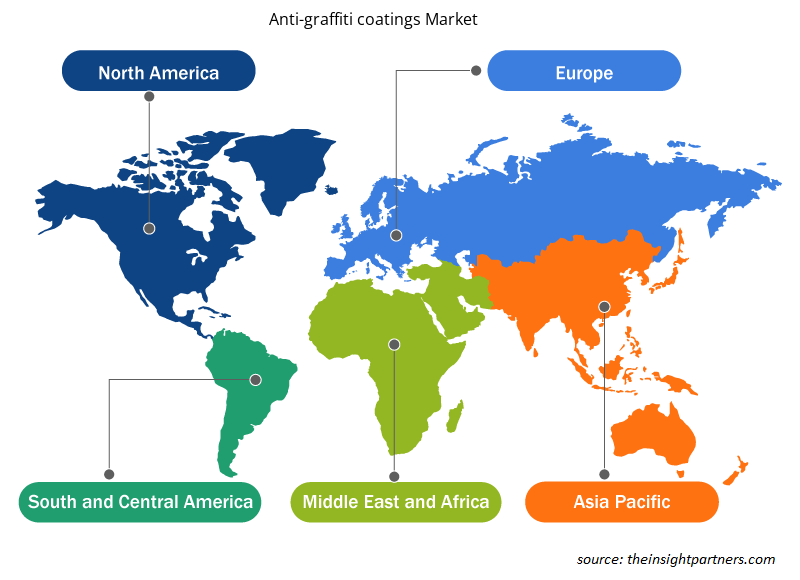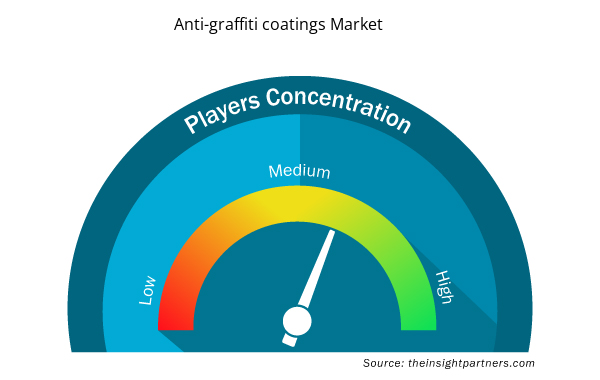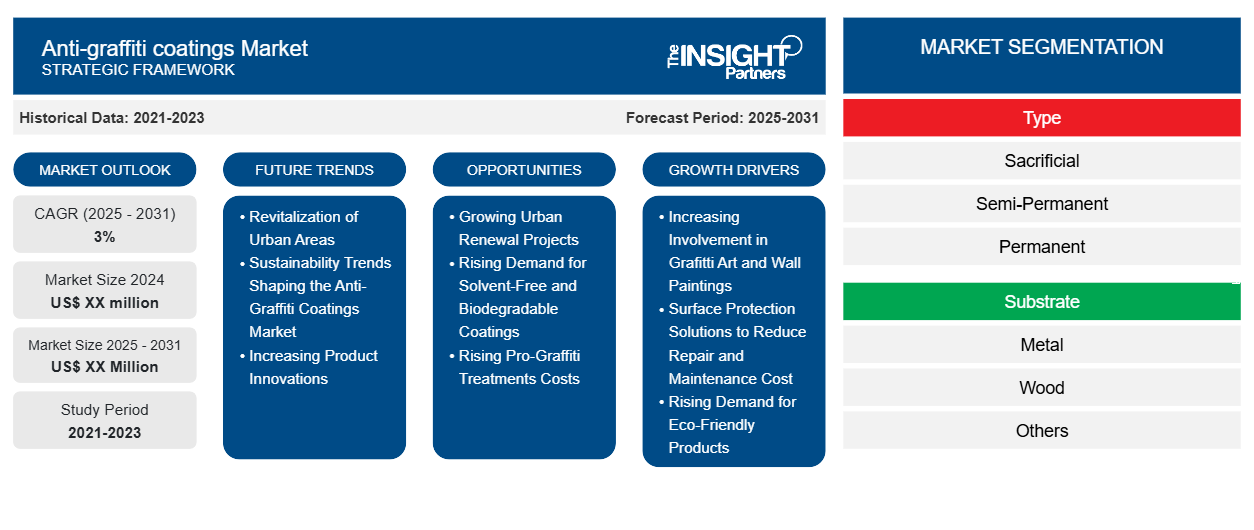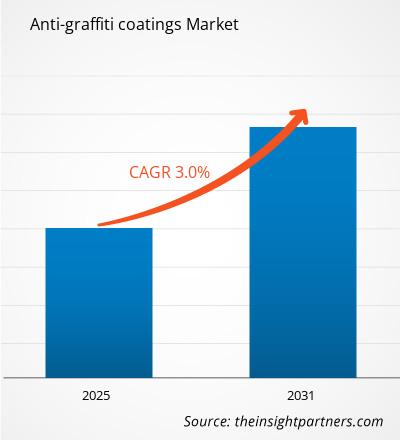من المتوقع أن يسجل سوق الطلاءات المضادة للكتابات على الجدران معدل نمو سنوي مركب بنسبة 3٪ من عام 2024 إلى عام 2031، مع توسع حجم السوق من XX مليون دولار أمريكي في عام 2024 إلى XX مليون دولار أمريكي بحلول عام 2031.
تم تقسيم التقرير حسب النوع (التضحية، شبه الدائم، الدائم). يتم تقسيم التحليل العالمي بشكل أكبر على المستوى الإقليمي والدول الرئيسية. يقدم التقرير أيضًا تحليلًا يعتمد على الركيزة (المعدن والخشب وغيرها). يتم تقسيم التحليل العالمي بشكل أكبر على المستوى الإقليمي والدول الرئيسية. يتم تغطية حجم السوق والتوقعات على المستويات العالمية والإقليمية والقطرية لجميع قطاعات السوق الرئيسية ضمن النطاق. يقدم التقرير القيمة بالدولار الأمريكي للتحليل والقطاعات المذكورة أعلاه. يقدم التقرير إحصائيات رئيسية عن حالة السوق للاعبين الرئيسيين في السوق ويعرض اتجاهات السوق والفرص.
غرض التقرير
يهدف تقرير سوق الطلاءات المضادة للكتابة على الجدران الصادر عن The Insight Partners إلى وصف المشهد الحالي والنمو المستقبلي وأهم العوامل الدافعة والتحديات والفرص. سيوفر هذا رؤى لمختلف أصحاب المصلحة في الأعمال التجارية، مثل:
- مزودي/مصنعي التكنولوجيا: لفهم ديناميكيات السوق المتطورة ومعرفة فرص النمو المحتملة، وتمكينهم من اتخاذ قرارات استراتيجية مستنيرة.
- المستثمرون: إجراء تحليل شامل للاتجاهات فيما يتعلق بمعدل نمو السوق، وتوقعات السوق المالية، والفرص المتاحة عبر سلسلة القيمة.
- الهيئات التنظيمية: لتنظيم السياسات ومراقبة الأنشطة في السوق بهدف تقليل الانتهاكات والحفاظ على ثقة المستثمرين ودعم سلامة السوق واستقرارها.
تجزئة سوق الطلاءات المضادة للكتابة على الجدران
يكتب
- تضحية
- شبه دائم
- دائم
الركيزة
- معدن
- خشب
- آحرون
صناعة المستخدم النهائي
- بناء
- مواصلات
الجغرافيا
- أمريكا الشمالية
- أوروبا
- آسيا والمحيط الهادئ
- أمريكا الجنوبية والوسطى
- الشرق الأوسط وأفريقيا
قم بتخصيص هذا التقرير ليناسب متطلباتك
ستحصل على تخصيص لأي تقرير - مجانًا - بما في ذلك أجزاء من هذا التقرير، أو تحليل على مستوى الدولة، وحزمة بيانات Excel، بالإضافة إلى الاستفادة من العروض والخصومات الرائعة للشركات الناشئة والجامعات
- احصل على أهم اتجاهات السوق الرئيسية لهذا التقرير.ستتضمن هذه العينة المجانية تحليلاً للبيانات، بدءًا من اتجاهات السوق وحتى التقديرات والتوقعات.
عوامل نمو سوق الطلاءات المضادة للكتابة على الجدران
- زيادة المشاركة في فن الجرافيتي والرسم على الجدران: أدى تحول البنية الأساسية للمدينة إلى تطورات أفضل إلى زيادة حالات الشباب الذين يمارسون فن الجرافيتي على الجدران والأرصفة. تعمل الأسطح المقاومة للتخريب في المباني الحديثة كعلاج ممتاز لهذه المسألة، وبالتالي تم تبنيها بشكل متزايد من قبل البلديات المهتمة بالحفاظ على مظهر المبنى مع الحفاظ على قيم الممتلكات بشكل جيد.
- حلول حماية الأسطح لتقليل تكاليف الإصلاح والصيانة: يميل أصحاب العقارات ومديروها إلى حماية الأسطح في محاولة لتقليل تكاليف الإصلاح والصيانة وتعزيز الجمال الخارجي للمباني والهياكل. تساعد الطلاءات المضادة للكتابة على الجدران في تحقيق هذا الهدف، ولهذا السبب هناك اتجاه إيجابي في نمو تطبيقها في الأسواق التجارية والسكنية.
- الطلب المتزايد على المنتجات الصديقة للبيئة: على مدى السنوات القليلة الماضية، كان هناك ميل متزايد لاستخدام المزيد من المنتجات الصديقة للبيئة. وقد أدى هذا بدوره إلى اختراق سوق الطلاءات المضادة للكتابة على الجدران. على سبيل المثال، يسعى المصنعون إلى جعل مثل هذه الطلاءات قابلة للتحلل البيولوجي ومنخفضة المركبات العضوية المتطايرة بحيث تجتذب المستهلكين والشركات الحريصة على صحة البيئة وهذا بدوره يوسع قاعدة السوق.
اتجاهات مستقبلية في سوق الطلاءات المضادة للكتابة على الجدران
- تنشيط المناطق الحضرية: مع تركيز المناطق الحضرية على التنشيط والتطوير، من المتوقع أن يزداد الطلب على الطلاءات المضادة للكتابة على الجدران. وستسعى البلديات إلى إيجاد حلول فعّالة لحماية الأماكن العامة والممتلكات من التخريب، مما سيدفع نمو السوق.
- اتجاهات الاستدامة التي تشكل سوق الطلاءات المضادة للكتابات على الجدران: سيشكل الاتجاه نحو الاستدامة سوق الطلاءات المضادة للكتابات على الجدران، حيث يطور المصنعون خيارات صديقة للبيئة. ستجذب التركيبات القابلة للتحلل البيولوجي ومنخفضة المركبات العضوية المتطايرة المستهلكين والشركات المهتمين بالبيئة، مما يوسع نطاق السوق.
- زيادة ابتكارات المنتجات: ستركز الابتكارات المستقبلية في الطلاءات المضادة للكتابات على تحسين المتانة وسهولة التطبيق. ومن شأن التطورات التي تعمل على تحسين مقاومة العوامل الجوية وتسهيل التنظيف أن تدفع الطلب في كل من التطبيقات التجارية والسكنية.
فرص سوق الطلاءات المضادة للكتابة على الجدران
- مشاريع التجديد الحضري المتنامية: يواصل الاتجاه الأخير لمشاريع التجديد الحضري خلق سوق ثابتة لطلاءات مكافحة الكتابة على الجدران. ويميل المزيد والمزيد من البلديات والأفراد إلى حماية البنية التحتية والأسطح الحضرية من أجل الحفاظ على قيمتها الجمالية والاقتصادية، مما يخلق سوقًا مستمرًا.
- الطلب المتزايد على الطلاءات الخالية من المذيبات والقابلة للتحلل البيولوجي: تتجه اتجاهات الاستدامة أيضًا إلى سوق الطلاءات المضادة للكتابة على الجدران. ومن المؤكد أن الشركات التي تصنع الطلاءات الخالية من المذيبات والقابلة للتحلل البيولوجي ستكون قادرة على تلبية الاحتياجات البيئية المتزايدة للسكان والشركات.
- ارتفاع تكاليف علاجات مكافحة الكتابة على الجدران: توقعًا لتأثيرات ارتفاع التكاليف على أصحاب العقارات، وخاصةً بمجرد أن يدركوا مدى تكلفة إزالة مثل هذه العلاجات لمكافحة الكتابة على الجدران، فإن الطلب على التدابير الاستباقية مثل الطلاءات المضادة للكتابة على الجدران متجذر. وفي ضوء ذلك، من المرجح أن يستفيد المصنعون من بيع منتجاتهم كحلول وقائية طويلة الأمد.
رؤى إقليمية حول سوق الطلاءات المضادة للكتابة على الجدران
لقد قام المحللون في Insight Partners بشرح الاتجاهات والعوامل الإقليمية المؤثرة على سوق الطلاءات المضادة للكتابات على الجدران طوال فترة التوقعات بشكل شامل. يناقش هذا القسم أيضًا قطاعات سوق الطلاءات المضادة للكتابات على الجدران والجغرافيا في جميع أنحاء أمريكا الشمالية وأوروبا ومنطقة آسيا والمحيط الهادئ والشرق الأوسط وأفريقيا وأمريكا الجنوبية والوسطى.

- احصل على البيانات الإقليمية المحددة لسوق الطلاءات المضادة للكتابة على الجدران
نطاق تقرير سوق الطلاءات المضادة للكتابة على الجدران
| سمة التقرير | تفاصيل |
|---|---|
| حجم السوق في عام 2024 | XX مليون دولار أمريكي |
| حجم السوق بحلول عام 2031 | XX مليون دولار أمريكي |
| معدل النمو السنوي المركب العالمي (2025 - 2031) | 3% |
| البيانات التاريخية | 2021-2023 |
| فترة التنبؤ | 2025-2031 |
| القطاعات المغطاة | حسب النوع
|
| المناطق والدول المغطاة | أمريكا الشمالية
|
| قادة السوق وملفات تعريف الشركات الرئيسية |
|
كثافة اللاعبين في سوق الطلاءات المضادة للكتابة على الجدران: فهم تأثيرها على ديناميكيات الأعمال
يشهد سوق الطلاءات المضادة للكتابات على الجدران نموًا سريعًا، مدفوعًا بالطلب المتزايد من المستخدم النهائي بسبب عوامل مثل تفضيلات المستهلكين المتطورة والتقدم التكنولوجي والوعي المتزايد بفوائد المنتج. ومع ارتفاع الطلب، تعمل الشركات على توسيع عروضها والابتكار لتلبية احتياجات المستهلكين والاستفادة من الاتجاهات الناشئة، مما يؤدي إلى زيادة نمو السوق.
تشير كثافة اللاعبين في السوق إلى توزيع الشركات أو المؤسسات العاملة في سوق أو صناعة معينة. وهي تشير إلى عدد المنافسين (اللاعبين في السوق) الموجودين في مساحة سوق معينة نسبة إلى حجمها أو قيمتها السوقية الإجمالية.
الشركات الرئيسية العاملة في سوق الطلاءات المضادة للكتابة على الجدران هي:
- شركة 3M
- اكزو نوبل ان في
- باسف اس اي
- شركة سي إس إل سيليكونز
- إي دو بونت دي نيمور وشركاه
إخلاء المسؤولية : الشركات المذكورة أعلاه ليست مرتبة بأي ترتيب معين.

- احصل على نظرة عامة على أهم اللاعبين الرئيسيين في سوق الطلاءات المضادة للكتابة على الجدران
نقاط البيع الرئيسية
- التغطية الشاملة: يغطي التقرير بشكل شامل تحليل المنتجات والخدمات والأنواع والمستخدمين النهائيين لسوق طلاءات مكافحة الكتابة على الجدران، مما يوفر صورة شاملة.
- تحليل الخبراء: تم تجميع التقرير على أساس الفهم العميق لخبراء الصناعة والمحللين.
- معلومات محدثة: يضمن التقرير أهمية الأعمال التجارية بسبب تغطيته للمعلومات الحديثة واتجاهات البيانات.
- خيارات التخصيص: يمكن تخصيص هذا التقرير لتلبية متطلبات العملاء المحددة وبما يتناسب مع استراتيجيات العمل بشكل مناسب.
وبالتالي، فإن تقرير البحث حول سوق الطلاءات المضادة للكتابة على الجدران يمكن أن يساعد في تمهيد الطريق لفك شفرة وفهم سيناريو الصناعة وآفاق النمو. ورغم وجود بعض المخاوف المشروعة، فإن الفوائد الإجمالية لهذا التقرير تميل إلى التفوق على العيوب.
- التحليل التاريخي (سنتان)، السنة الأساسية، التوقعات (7 سنوات) مع معدل النمو السنوي المركب
- تحليل PEST و SWOT
- حجم السوق والقيمة / الحجم - عالميًا وإقليميًا وقطريًا
- الصناعة والمنافسة
- مجموعة بيانات Excel



Report Coverage
Revenue forecast, Company Analysis, Industry landscape, Growth factors, and Trends

Segment Covered
This text is related
to segments covered.

Regional Scope
North America, Europe, Asia Pacific, Middle East & Africa, South & Central America

Country Scope
This text is related
to country scope.
الأسئلة الشائعة
Urban development initiatives is expected to be the key market trends
Based on geography, North America held the largest share of the anti-graffiti coatings market due to the rising vandalism cases across the region
Based on type, the sacrificial segment is expected to witness the fastest growth during the forecast period
The Anti-graffiti coatings Market is estimated to witness a CAGR of 3% from 2023 to 2031
Urbanization and vandalism concerns is driving the market growth
3M Company; BASF SE; DuPont; Sherwin-Williams; Akzo Nobel; Sika AG; RPM International; Henkel AG; Rainguard Brands; Graffiti Shield; Rust-Oleum; SEI Industrial Chemicals; Guard Industry; Urban Hygiene; CSL Silicones Inc.
1.3M Company
2.Akzo Nobel NV
3.BASF SE
4.CSL Silicones Inc.
5.E. I. du Pont de Nemours and Company
6.Hydron Protective Coatings
7.Protective Coatings International Ltd.
8.Sherwin-Williams Company
9.Sika AG
10.Valspar Corporation
The Insight Partners performs research in 4 major stages: Data Collection & Secondary Research, Primary Research, Data Analysis and Data Triangulation & Final Review.
- Data Collection and Secondary Research:
As a market research and consulting firm operating from a decade, we have published and advised several client across the globe. First step for any study will start with an assessment of currently available data and insights from existing reports. Further, historical and current market information is collected from Investor Presentations, Annual Reports, SEC Filings, etc., and other information related to company’s performance and market positioning are gathered from Paid Databases (Factiva, Hoovers, and Reuters) and various other publications available in public domain.
Several associations trade associates, technical forums, institutes, societies and organization are accessed to gain technical as well as market related insights through their publications such as research papers, blogs and press releases related to the studies are referred to get cues about the market. Further, white papers, journals, magazines, and other news articles published in last 3 years are scrutinized and analyzed to understand the current market trends.
- Primary Research:
The primarily interview analysis comprise of data obtained from industry participants interview and answers to survey questions gathered by in-house primary team.
For primary research, interviews are conducted with industry experts/CEOs/Marketing Managers/VPs/Subject Matter Experts from both demand and supply side to get a 360-degree view of the market. The primary team conducts several interviews based on the complexity of the markets to understand the various market trends and dynamics which makes research more credible and precise.
A typical research interview fulfils the following functions:
- Provides first-hand information on the market size, market trends, growth trends, competitive landscape, and outlook
- Validates and strengthens in-house secondary research findings
- Develops the analysis team’s expertise and market understanding
Primary research involves email interactions and telephone interviews for each market, category, segment, and sub-segment across geographies. The participants who typically take part in such a process include, but are not limited to:
- Industry participants: VPs, business development managers, market intelligence managers and national sales managers
- Outside experts: Valuation experts, research analysts and key opinion leaders specializing in the electronics and semiconductor industry.
Below is the breakup of our primary respondents by company, designation, and region:

Once we receive the confirmation from primary research sources or primary respondents, we finalize the base year market estimation and forecast the data as per the macroeconomic and microeconomic factors assessed during data collection.
- Data Analysis:
Once data is validated through both secondary as well as primary respondents, we finalize the market estimations by hypothesis formulation and factor analysis at regional and country level.
- Macro-Economic Factor Analysis:
We analyse macroeconomic indicators such the gross domestic product (GDP), increase in the demand for goods and services across industries, technological advancement, regional economic growth, governmental policies, the influence of COVID-19, PEST analysis, and other aspects. This analysis aids in setting benchmarks for various nations/regions and approximating market splits. Additionally, the general trend of the aforementioned components aid in determining the market's development possibilities.
- Country Level Data:
Various factors that are especially aligned to the country are taken into account to determine the market size for a certain area and country, including the presence of vendors, such as headquarters and offices, the country's GDP, demand patterns, and industry growth. To comprehend the market dynamics for the nation, a number of growth variables, inhibitors, application areas, and current market trends are researched. The aforementioned elements aid in determining the country's overall market's growth potential.
- Company Profile:
The “Table of Contents” is formulated by listing and analyzing more than 25 - 30 companies operating in the market ecosystem across geographies. However, we profile only 10 companies as a standard practice in our syndicate reports. These 10 companies comprise leading, emerging, and regional players. Nonetheless, our analysis is not restricted to the 10 listed companies, we also analyze other companies present in the market to develop a holistic view and understand the prevailing trends. The “Company Profiles” section in the report covers key facts, business description, products & services, financial information, SWOT analysis, and key developments. The financial information presented is extracted from the annual reports and official documents of the publicly listed companies. Upon collecting the information for the sections of respective companies, we verify them via various primary sources and then compile the data in respective company profiles. The company level information helps us in deriving the base number as well as in forecasting the market size.
- Developing Base Number:
Aggregation of sales statistics (2020-2022) and macro-economic factor, and other secondary and primary research insights are utilized to arrive at base number and related market shares for 2022. The data gaps are identified in this step and relevant market data is analyzed, collected from paid primary interviews or databases. On finalizing the base year market size, forecasts are developed on the basis of macro-economic, industry and market growth factors and company level analysis.
- Data Triangulation and Final Review:
The market findings and base year market size calculations are validated from supply as well as demand side. Demand side validations are based on macro-economic factor analysis and benchmarks for respective regions and countries. In case of supply side validations, revenues of major companies are estimated (in case not available) based on industry benchmark, approximate number of employees, product portfolio, and primary interviews revenues are gathered. Further revenue from target product/service segment is assessed to avoid overshooting of market statistics. In case of heavy deviations between supply and demand side values, all thes steps are repeated to achieve synchronization.
We follow an iterative model, wherein we share our research findings with Subject Matter Experts (SME’s) and Key Opinion Leaders (KOLs) until consensus view of the market is not formulated – this model negates any drastic deviation in the opinions of experts. Only validated and universally acceptable research findings are quoted in our reports.
We have important check points that we use to validate our research findings – which we call – data triangulation, where we validate the information, we generate from secondary sources with primary interviews and then we re-validate with our internal data bases and Subject matter experts. This comprehensive model enables us to deliver high quality, reliable data in shortest possible time.


 احصل على عينة مجانية لهذا التقرير
احصل على عينة مجانية لهذا التقرير